Zeiss Otus ML 50mm f/1.4 Lens Review

The all-manual Zeiss 50mm f/1.4 Otus ML Lens blends a frequently needed focal length, military-grade construction, and luxury-grade precision and aesthetics with superb image quality.
- High utility focal length
- Superb image quality.
- Rugged metal build quality
- High precision, super smooth, repeatable MF
- High-visibility yellow scale engravings
- Manual focus only, manual aperture only
- Strong color blur at f/1.4
- Slightly heavy
- Expensive
- B&H Photo(strongly recommended)
- Adorama
 Wex Photographic
Wex Photographic- eBay (choose trustworthy sellers only)
- Check the used inventory at:
B&H | KEH | Adorama | MPB - Rent it here: Lensrentals.com
The 50mm f/1.4 Otus ML is the first Zeiss Lens introduced in over 6 years, and additional ones are promised.
Zeiss is renowned for their extraordinarily high-quality products, but they reserve the "Otus" brand for their flagship lenses. These extremely rugged all-metal lenses are a pleasure to use and provide an exceptional manual focus (only) experience and superb image quality.
This is not the first Otus lens reviewed on this site. However, all of the previous Otus lenses were significantly larger and considerably more expensive than this one. Were sacrifices made for that achievement?
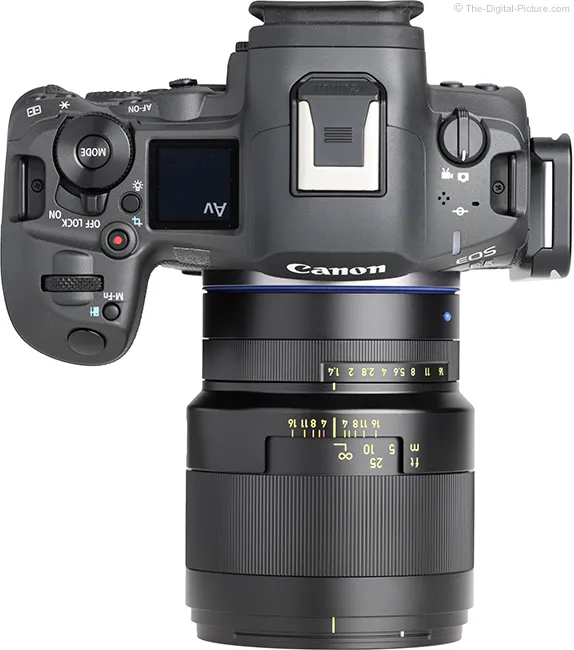
Focal Length
Back to TopFocal length is the first consideration for lens selection, and with a prime lens, you get only one angle of view. That angle of view drives subject distance choices (or meets distance-related requirements), and subject distances determine perspective.
On a full-frame body, a 50mm focal length provides an angle of view that seems natural, and that aspect brings great general-purpose usefulness. So useful, and thus, so popular, is this focal length that 50mm (or similar) focal length prime lenses are found in all major brand lens lineups, with some brands having many options.

50mm lenses are frequently used for fashion, portraiture, weddings, documentary, street, lifestyle, architecture, landscape, commercial, around-the-home, and general studio photography applications, including product photography or recording your lunch. As you likely noted, many useful applications for this lens include people as subjects. While a 50mm lens on a full-frame body is modestly too wide for tightly framed headshot portraits (a too-close perspective is required), this angle of view is excellent for wider portrait framing.

50mm is a great option for video recording. Having a 50mm focal length with an f/1.4 aperture available opens many artistic opportunities, including those found in nature.
To visualize where 50mm fits among other common focal lengths, I'll borrow a focal length range example from a zoom lens review.

On an ASP-C/1.6x sensor format body, the 50mm focal length provides an angle of view like an 80mm lens on a full-frame sensor format Canon body, a 75mm on a Sony. Uses for this angle of view coincide with most uses of the 50mm focal length, with modestly tighter framing or modestly longer perspective for the same framing being the difference. The APS-C angle of view favors more tightly framed portraits.
Note that this lens's manual-focus-only feature limits use to scenarios within your manual focusing ability.

Max Aperture
Back to TopThis lens's f/1.4 max aperture is not the widest available at 50mm, but it is not far from it, and f/1.4 is still ultra-wide.
F/1.4 allows a significant amount of light to reach the imaging sensor. Use that light to enable action (subject and camera) stopping shutter speeds in low light levels while keeping ISO settings and noise levels low. It seems there is always enough light for handholding 50mm at f/1.4.
Another advantage of a wide aperture lens is the background blur it can create. 50mm f/1.4 with a close subject creates a shallow DOF, drawing the viewer's eye to the in-focus subject against a smoothly blurred background.
This example illustrates the maximum blur this lens can create:

The background encompasses a significant percentage of many images, and when the background is not complementary to the subject (or even distracting), blurring it away is highly advantageous.
Let's view the maximum blur available at a range of apertures.

Compare the aperture of your widest 50mm lens to f/1.4.
If there were no disadvantages to a wide aperture, every lens would have one. A wide aperture requires increased lens element size, which comes with the additional penalties of heavier weight and higher cost. Ultra-light weight is not the Zeiss Otus goal, but this lens is still modest in its weight and size.
Aperture is manually (only) selected via a small, metal-ribbed aperture ring near the lens mount. The short-throw ring is clicked by default, with a small tool provided to disable the clicks, allowing for smooth adjustments. While manual aperture selection may seem challenging for some uses, this limitation is seldom a problem for me.
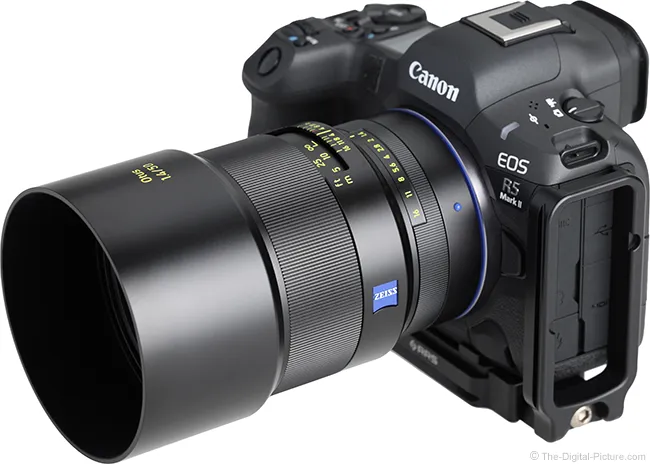
Image Stabilization
Back to TopThe 50mm and f/1.4 combination is usually handholdable without ultra-high ISO settings, and the Canon RF 50mm F1.4 L VCM Lens does not feature optical image stabilization. Omitting the optical stabilization system reduces the lens's size, weight, complexity, and cost. However, image stabilization is a very useful feature, especially when narrow apertures are needed.
Canon, Sony, and Nikon address that omission with IBIS (In-Body Image Stabilization) in some camera models. In addition to reducing camera shake, the stabilized imaging sensor provides a still viewfinder image, enabling careful composition. Furthermore, sensor-based AF leverages the stabilized view for enhanced accuracy.
With no IS switch on the lens, the camera menu must be used to enable or disable IBIS or check the current settings. This extra step is a slight impediment to working quickly, such as when transitioning from tripod-mounted to handheld.
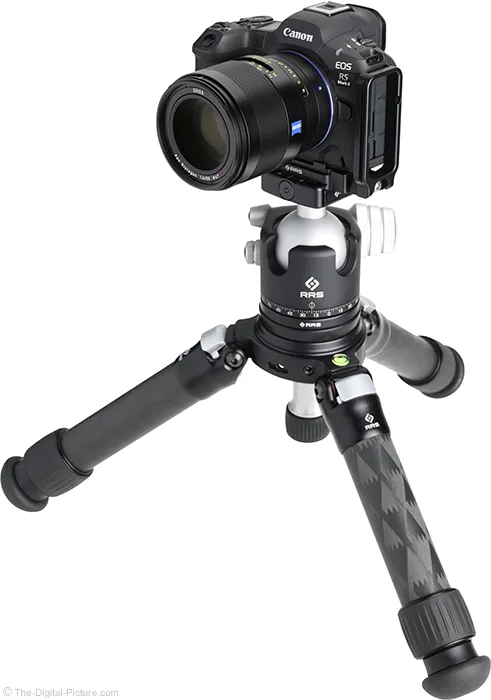
Image Quality
Back to TopA flagship product from a company with a deep reputation for outstanding image quality sets expectations high. So, how does the Zeiss 50mm f/1.4 Otus ML Lens perform optically? I couldn't wait to find out.
When the RF mount Zeiss 50mm f/1.4 Otus ML Lens landed in the studio, the highest priority was to produce the Image quality test results.
Generally, the sharper the lens, the easier it is to achieve perfect focus. When all visible colors are not focused on the same plane, establishing optimal focus is extremely difficult.
Do you see the color fringing in the center of this lens's f/1.4 test sample? It cost me hours of work. Rarely does a second round of testing improve the results, but I had to be certain that the results were accurate. They were. The second round of testing produced the same results.
Focus can be adjusted to remove the color blur from this lens's results, but doing so diminishes the sharpness of the resolution lines. Here is that example:

Color blur is not unusual, and we have seen similar results before from Zeiss:
Compared to the Zeiss Milvus 50mm f/1.4 Lens
However, modern lenses usually keep the plane of sharpest focus color-free. I'll share a three-dimensional example and discuss the color blur below.
This lens offers excellent resolution at f/1.4; however, the color blur affects overall sharpness. Stopping down only 1/3 of a stop to f/1.6 removes the color from the chart and creates a noticeably improved result. In the center of the frame, this lens is razor-sharp at f/2, and crazy-sharp at f/2.8.
Lenses typically produce decreased sharpness in the periphery of the image circle, where light rays are refracted to a stronger angle than in the center. This lens's f/1.4 color blur is not affecting the image circle periphery, and the corner test results are nice. By f/2.8, especially with the peripheral shading clearing, this lens produces outstanding corner sharpness.
The resolution chart is merciless on image quality, especially with the impact of color blur, so let's take the testing outdoors. Next, we'll look at a series of center-of-the-frame 100% resolution crop examples. These images were captured in RAW format by a Canon EOS R5 Mark II and processed in Canon's Digital Photo Professional (DPP) using the Standard Picture Style with sharpness set to 1 on a 0-10 scale. Note that images from most cameras require some level of sharpening; however, excessively high sharpness settings can be destructive to image details and mask the deficiencies of a lens.

If I didn't show the f/2 results, you would likely consider the f/1.4 results great. However, the f/2 results are really impressive.
Next, we'll examine a series of comparisons that show 100% resolution extreme top-left corner crops captured and processed identically to the above center-of-the-frame images. The lens was manually focused in the corner of the frame to capture these images.

Count on samples taken from the outer extreme of the image circle, full-frame corners, to reveal a lens's weakest performance. That said, there are few lenses capable of producing such wide-open corner image quality, and the fact that this lens achieved these results at f/1.4 increases the remarkableness.
This lens does not exhibit focus shift, the plane of sharp focus moving forward or backward as the aperture is narrowed (residual spherical aberration or RSA).
When used on a camera that utilizes its full image circle, a lens is expected to show peripheral shading at the widest aperture settings. The about 3.5 stops of corner shading are noticeable. However, that amount is normal for this lens class.
Peripheral shading decreases to about two stops at f/2, just over one stop at f/2.8, and about one stop from f/4 through f/16.
APS-C format cameras using lenses projecting a full-frame-sized image circle avoid most vignetting problems. In this case, the about one-stop of corner shading showing at f/1.4 may be visible in select images, primarily those with a solid color (such as a blue sky) in the corners.
One-stop of shading is often considered the number of visibility, though subject details provide a widely varying amount of vignetting discernibility. Vignetting is correctable during post-processing, with increased noise in the brightened areas the penalty, or it can be embraced, using the effect to draw the viewer's eye to the center of the frame. Study the pattern shown in our vignetting test tool to determine how your images will be affected.
Lateral (or transverse) CA (Chromatic Aberration) refers to the unequal magnification of all colors in the spectrum. Lateral CA shows as color fringing along lines of strong contrast running tangential (meridional, right angles to radii), with the mid and especially the periphery of the image circle showing the most significant amount, as this is where the most significant difference in the magnification of wavelengths typically exists.
With the right lens profile and software, lateral CA is often easily correctable (often in the camera) by radially shifting the colors to coincide. However, it is always better to avoid this aberration in the first place.
Color misalignment can be observed in the site's image quality tool; however, let's also examine a worst-case example. The image below is a 100% crop from the extreme top-left corner of an EOS R5 II frame showing diagonal black and white lines.
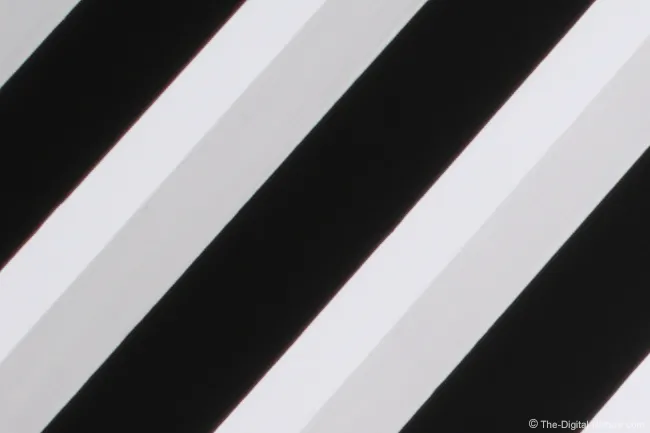
This image should only contain black and white colors, and this result is excellent.
A relatively common lens aberration is axial (longitudinal, bokeh) CA, which causes non-coinciding focal planes of the various wavelengths of light. More simply, different colors of light are focused to different depths. Spherical aberration, along with spherochromatism, or a change in the amount of spherical aberration with respect to color (looks quite similar to axial chromatic aberration but is hazier) are other common lens aberrations to observe. Axial CA remains somewhat persistent when stopping down, with the color misalignment effect increasing with defocusing. The spherical aberration color halo exhibits minimal size change as the lens is defocused, and stopping down one to two stops generally eliminates this aberration.
In the real world, lens defects do not exist in isolation, with spherical aberration and spherochromatism generally found, at least to some degree, along with axial CA. These combine to create a less sharp, hazy-appearing image quality at the widest apertures.
The wide-open aperture examples below compare the fringing colors of the defocused specular highlights in the foreground to the background. The lens has introduced any differences from the neutrally colored subjects.

Finishing the color blur discussion started in the sharpness topic, we see strong color blur at f/1.4. The blur reduces as the aperture narrows until f/4, at which point, the colors are practically gone.
Bright light reflecting off lens elements' surfaces may cause flare and ghosting, resulting in reduced contrast and sometimes interesting, usually objectionable visual artifacts. The shape, intensity, and position of the flare and ghosting effects in an image are variable, dependent on the position and nature of the light source (or sources), selected aperture, shape of the aperture blades, and quantity and quality of the lens elements and their coatings. Additionally, flare and ghosting can impact AF performance.
This lens features Zeiss T* antireflective coating to suppress flare and ghosting, and it produced practically no flare effects even at narrow apertures in our standard sun-in-the-corner-of-the-frame flare test, a remarkable performance.
Flare effects can either be embraced or avoided, or removal can be attempted, although this process can be challenging. Thus, this lens's high flare resistance is a welcome trait.
Two lens aberrations are particularly evident in images of stars, mainly because bright points of light against a dark background make them easier to see. Coma occurs when light rays from a point of light spread out from that point instead of being refocused as a point on the sensor. Coma is absent in the center of the frame, gets worse toward the edges/corners, and generally appears as a comet-like or triangular tail of light that can be oriented either away from the center of the frame (external coma) or toward the center of the frame (internal coma). The coma clears as the aperture is narrowed. Astigmatism is seen as points of light spreading into a line, either sagittal (radiating from the center of the image) or meridional (tangential, perpendicular to sagittal). This aberration can produce stars appearing to have wings. Remember that Lateral CA is another aberration that is apparent in the corners.
The image below is a 100% crop taken from near the top-left corner of an EOS R5 II image captured at f/1.4.
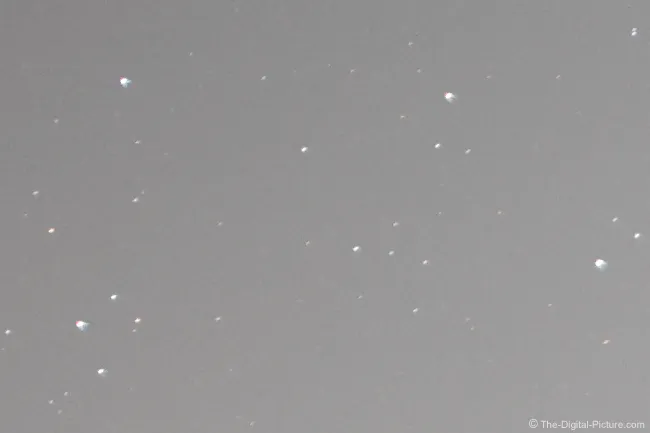
The peripheral stars are taking on a modest jellyfish shape, which is not optimal.
The 50mm f/1.4 Otus ML has slight pincushion distortion.
As seen earlier in the review, it is easy to illustrate the strongest blur a lens can create. Due to the infinite number of variables present among available scenes, assessing the blur quality, bokeh, is considerably more challenging. Here are some f/11 (for diaphragm blade interaction) 100% crop examples.
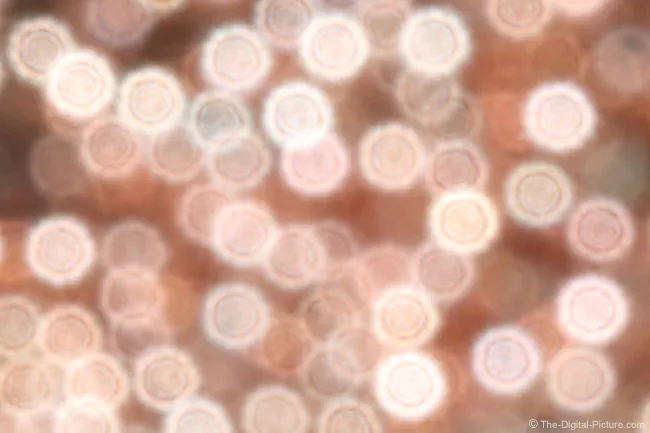
The first example shows defocused highlights rather smoothly filled and quite rounded for 6 stops closed. The outdoor examples appear nice.
Except for a small number of specialty lenses, the wide aperture bokeh in the frame's corners does not show round defocused highlights, instead showing cat's-eye shapes due to a form of mechanical vignetting. If you look through a tube at an angle, similar to the light reaching the frame's corner, the shape is not round. That is the shape we're looking at here.

The peripheral shape truncation is moderate at f/1.4, but the truncation resolves as the aperture narrows.
A 10-blade diaphragm will create 10-point sunstars (diffraction spikes) from point light sources captured with a narrow aperture. Generally, the more a lens diaphragm is stopped down, the larger and better-shaped the sunstars tend to be. Wide-aperture lenses tend to have an advantage in this regard, and this lens can produce stunning stars, as illustrated below.
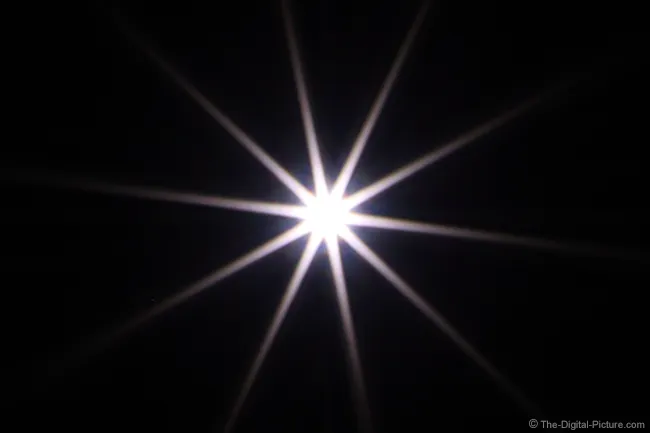
The example above was captured at f/16.
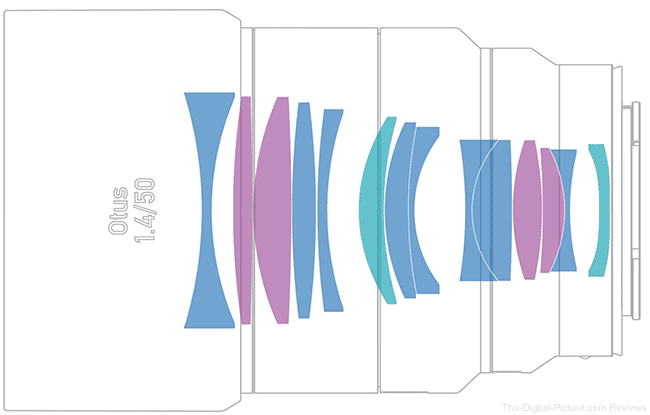
The 50mm f/1.4 Otus ML features a Distagon optical design, which includes two aspherical elements and four anomalous partial dispersion glass elements.
Overall, the Zeiss 50mm f/1.4 Otus ML Lens produces great f/1.4 image quality that is primarily held back by only color blur. Its f/2 image quality is outstanding.
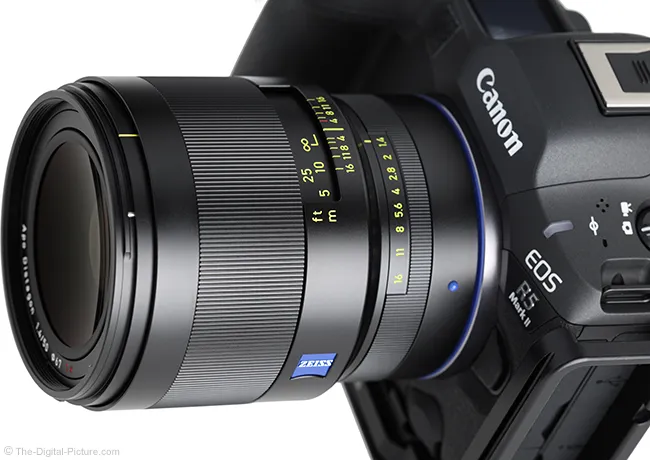
Is The Zeiss Look Real or Hype?
Back to Top"Engineered to reveal more than the naked eye, the apochromatic and aspherical lens design reduces chromatic aberrations and distortions to produce the classic ZEISS look characterized by sharpness, color fidelity, and three-dimensional quality." [press release]
We already viewed this lens's sharpness (contrast and resolution), aberrations, distortion, background blur capabilities, and bokeh, but let's go deeper, looking at a comparison with the Canon RF 50mm F1.4 L VCM Lens.
Note that the Zeiss 50mm f/1.4 provides a slightly narrower angle of view than the Canon and Sony equivalents. It frames the test chart from slightly farther away (6.02' vs. 5.59' and 5.74' / 1834mm vs. 1703mm and 1751mm), and enlarges details in comparison images taken from a stationary camera. Thus, the Zeiss results in these comparisons are reduced to 93.5% to closely align its details with the Canon results, making comparisons easier.
The images below were captured on the same camera, with the lenses focused at the same distance (same subject in foreground), and the images were processed identically in DPP, including sharpness = "1" and daylight white balance.
To keep your mind open, let's make this a blind A-B comparison. Determine which look you prefer, and I'll reveal the references below.

Here is another Zeiss Look comparison:
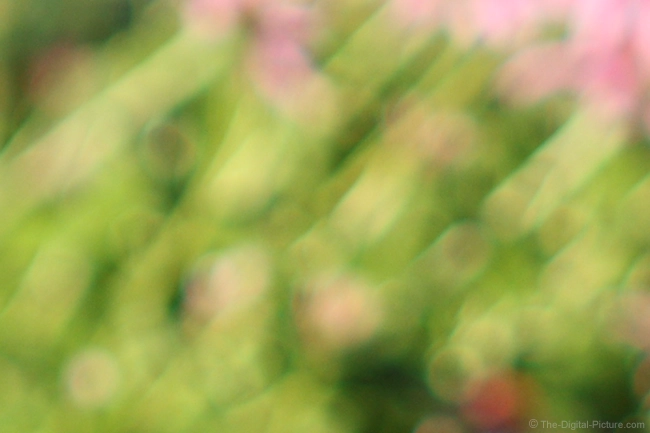
Do you see the smoother background blur produced by lens B? Did also you notice the slight color balance difference, with lens A creating a warmer tone? It's time to lock in your preference.
The Zeiss 50 is the A lens.
All lenses deliver a look, and ultra-wide aperture lenses deliver an outstanding look for isolated subjects. I'll let you decide if the Zeiss version look is your preference.
Focusing
Back to TopAccurate focus is critical for most images, and this manual-focus-only lens requires you to take complete responsibility for this task (your camera's focus peaking feature is your friend). The lack of autofocus is a show-stopper for many photographers, but those who have the time and desire to use manual focus will be impressed by this lens's manual focus performance.
"ZEISS lenses are known for their precise and satisfying mechanical engineering, and the new Otus ML lens family is no exception. In this case, the all-metal construction is centered around the manual focus experience, where the 260° of precision-dampened throw is complemented by the ridged metal focus ring for smooth and precise focusing. The lens body's precision scales, marked with characteristic ZEISS yellow engravings, further promote the precision manual focusing experience." [Zeiss/B&H]
With the 50 ML, Zeiss lenses continue to deliver the ultimate manual focus experience.
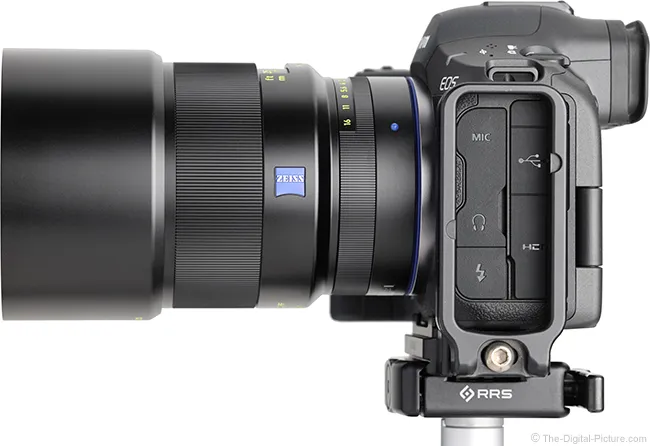
The metal-ribbed manual focus ring is moderately large and turns extremely smoothly and with ideal rotational resistance. Focus distance changes are imparted mechanically (not electronically) and slowly, making precise adjustment easy. The ring's rotation is limited, making adjustments repeatable, which is aided by the high-visibility yellow scale engravings. A DOF scale is included.
It is normal for the scene to change size in the frame as the focus is pulled from one extent to the other. This effect is focus breathing, a change in focal length resulting from a change in focus distance. Focus breathing impacts photographers who intend to use focus stacking techniques, videographers who pull focus (without movement to camouflage the effect), and anyone who critically frames while adjusting focus.
This lens produces a rather strong change in subject size through a full extent (worst-case) focus distance adjustment.

This lens has a minimum focus distance of 19.7" (500mm), where it generates a modest 0.14x maximum magnification spec. While 0.14x ranks this lens at the bottom of its class, most of the others do not significantly outperform it.
| Model | Min Focus Distance | Max Magnification | |
|---|---|---|---|
| Canon RF 50mm F1.2 L USM Lens | 15.7" | (400mm) | 0.19x |
| Canon RF 50mm F1.4 L VCM Lens | 15.7" | (400mm) | 0.15x |
| Sigma 50mm F1.2 DG DN Art Lens | 19.7" | (500mm) | 0.16x |
| Sigma 50mm F1.4 DG DN Art Lens | 17.7" | (450mm) | 0.15x |
| Sony FE 50mm F1.2 GM Lens | 15.7" | (400mm) | 0.17x |
| Sony FE 50mm F1.4 GM Lens | 16.1" | (410mm) | 0.16x |
| Zeiss 50mm f/1.4 Otus ML Lens | 19.7" | (500mm) | 0.14x |
| Zeiss 50mm f/1.4 Milvus Lens | 17.7" | (450mm) | 0.15x |
| Zeiss 55mm f/1.4 Otus Lens | 19.7" | (500mm) | 0.14x |
At this lens's minimum MF distance, a subject measuring approximately 9.9 x 6.6" (251 x 167mm) fills a full-frame imaging sensor.
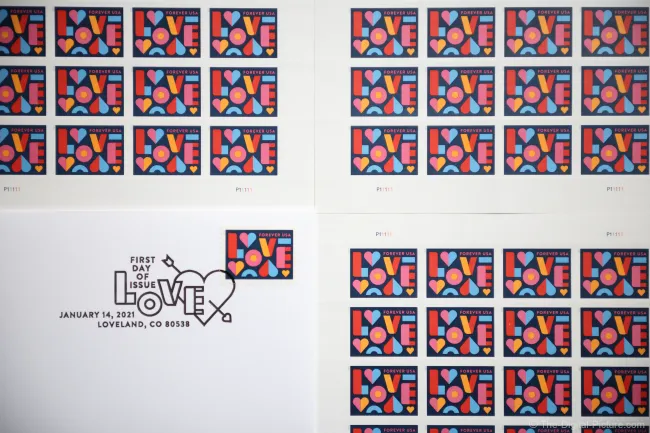
The individual USPS love stamps measure 1.19 x 0.91" (30 x 23mm).
While this lens produces sharp center-of-the-frame details at minimum focus distance with a wide-open aperture, the image periphery is modestly soft due to field curvature. The extreme corners are excellently sharp by f/5.6.
The minimum focus distance is measured from the imaging sensor plane with the balance of the camera, lens, and lens hood length taking their space out of the number to create the working distance. This lens provides a sufficient 14.9" (378mm) working distance without the hood installed and a still adequate 13.5" (343mm) with the hood mounted.
This lens is not compatible with Canon, Nikon, or Sony extenders or teleconverters.
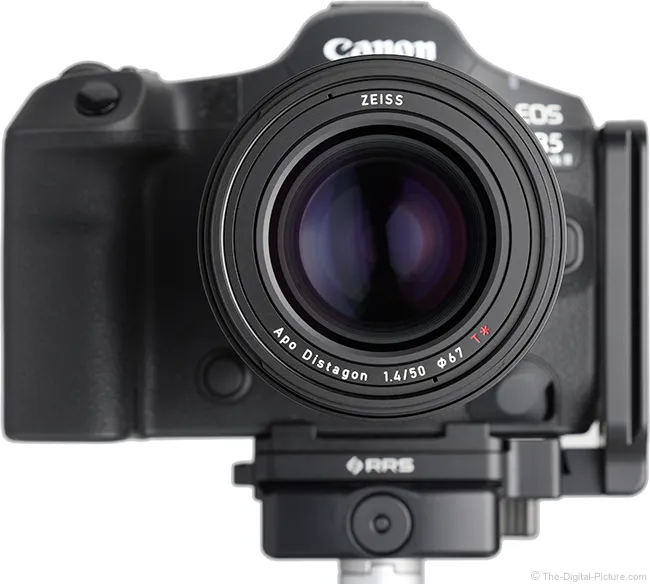
Design & Features
Back to TopThe Zeiss 50mm f/1.4 Otus ML Lens blends military-grade construction with luxury-grade precision and aesthetics. Those qualities make using this lens especially fun.
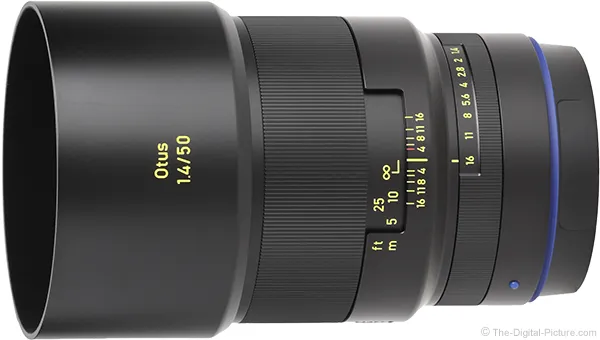
The 50 Otus ML features all-metal construction and a fixed size (but the focus ring moves in and out slightly).
There are no switches or buttons — just a super smooth focus ring and a slightly difficult-to-reach aperture ring. The de-click key, a tiny flat head screwdriver, enables or disables aperture ring clicks via a screw inside the lens mount.
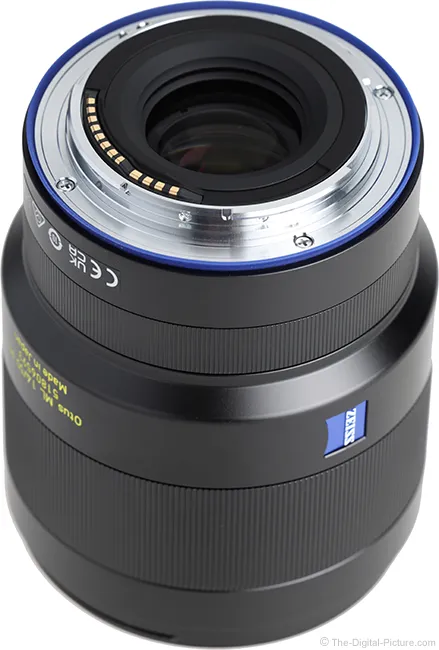
This lens is dust and moisture-resistant, including the stylish blue mount seal, though openings around the MF distance scale appear susceptible to debris at least partially entering into the lens.
This lens is slightly heavier than its rivals from other brands in the 50mm f/1.4 category.
| Model | Weight oz(g) | Dimensions w/o Hood "(mm) | Filter | Year | ||
|---|---|---|---|---|---|---|
| Canon RF 50mm F1.2 L USM Lens | 33.5 | (950) | 3.5 x 4.3 | (89.8 x 108.0) | 77 | 2018 |
| Canon RF 50mm F1.4 L VCM Lens | 20.5 | (580) | 3.0 x 3.9 | (76.5 x 99.3) | 67 | 2024 |
| Sigma 50mm F1.2 DG DN Art Lens | 26.1 | (740) | 3.2 x 4.4 | (81.0 x 110.8) | 72 | 2024 |
| Sigma 50mm F1.4 DG DN Art Lens | 23.3 | (660) | 3.1 x 4.4 | (78.2 x 111.5) | 72 | 2023 |
| Sony FE 50mm F1.2 GM Lens | 27.5 | (778) | 3.4 x 4.3 | (87.0 x 108.0) | 72 | 2021 |
| Sony FE 50mm F1.4 GM Lens | 18.2 | (516) | 3.2 x 3.8 | (80.6 x 96.0) | 67 | 2023 |
| Zeiss 50mm f/1.4 Otus ML Lens | 24.6 | (697) | 3.0 x 3.9 | (77.0 x 100.0) | 67 | 2025 |
| Zeiss 50mm f/1.4 Milvus Lens | 32.5 | (922) | 3.2 x 3.8 | (82.5 x 97.5) | 67 | 2015 |
| Zeiss 55mm f/1.4 Otus Lens | 36.4 | (1030) | 3.6 x 5.7 | (92.4 x 144.0) | 77 | 2013 |
View and compare the complete Zeiss 50mm f/1.4 Otus ML Lens Specifications in the site's lens specifications tool.
Here are some visual comparisons:
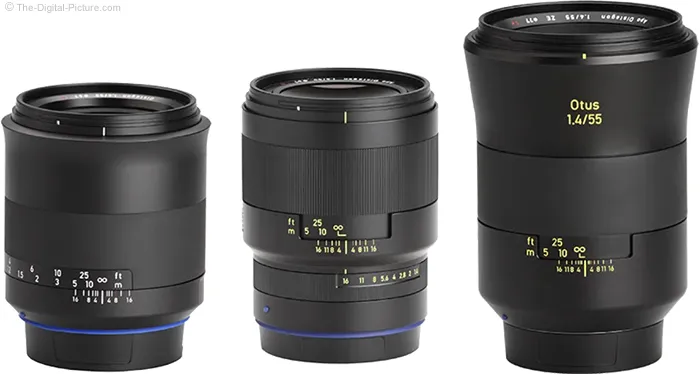
Positioned from left to right are the following Zeiss lenses:
50mm f/1.4 Milvus
50mm f/1.4 Otus ML
55mm f/1.4 Otus
Ignore the differences in lens mount cap size. The same lenses are shown below with their hoods in place.

The size difference between the two Otus lenses is dramatic:

Positioned above and below is the 50mm f/1.4 Otus ML between the similarly sized Sony FE 50mm F1.4 GM and Canon RF 50mm F1.4 L VCM.

Use the site's product image comparison tool to visually compare the Zeiss 50mm f/1.4 Otus ML Lens to other lenses.
This lens uses 67mm filters, a common size that is likely already in your kit.
Zeiss includes a strong metal lens hood in the box. The round, straight hood adds considerable protection from impact and stray light. A flocked interior avoids reflections.
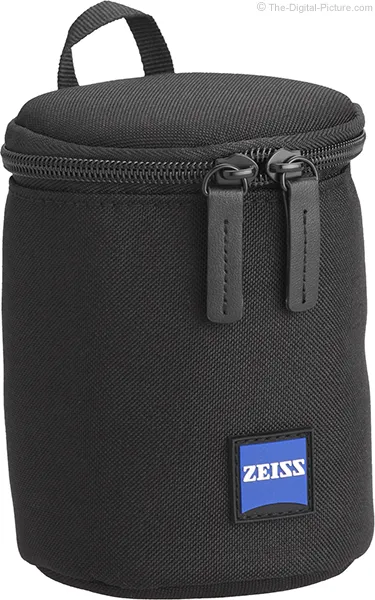
A zippered padded nylon case is also included.
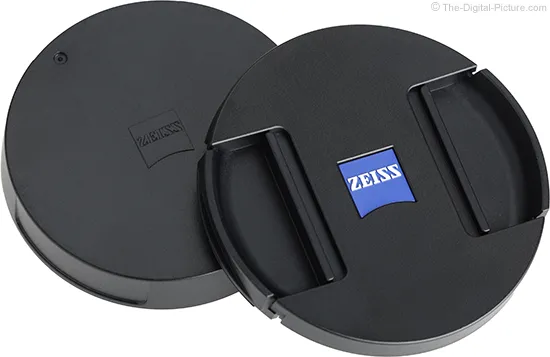
Price, Value, Compatibility
Back to TopThe price of Zeiss Otus lenses places them into a niche market.
The 50mm f/1.4 Otus ML is available in Canon RF, Nikon Z, and Sony E mounts.
Zeiss provides a 2-year limited warranty and a 3-year registration extension in the USA.
The reviewed Zeiss 50mm f/1.4 Otus ML Lens was retail sourced.
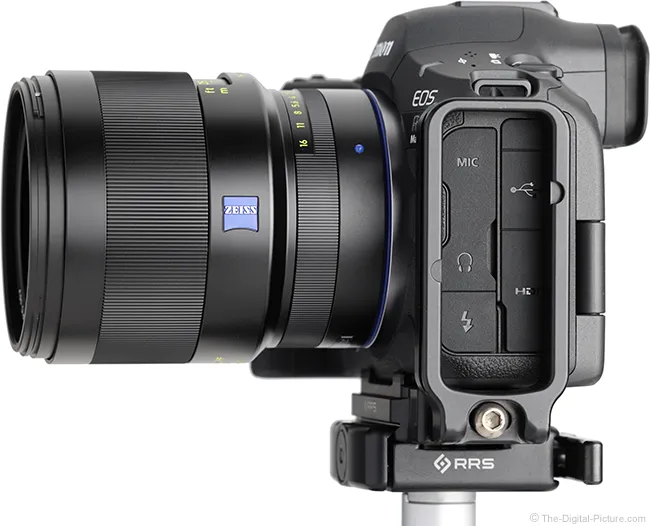
Alternatives
Back to TopThe extreme popularity of 50mm prime lenses means there are many direct comparisons available. I'll share a few of them.
Note that the Canon, Nikon, and Sigma alternatives feature AF, valuable to many of us, and a camera-determined aperture. Also note the Zeiss advantages of a superior all-metal build quality and a high-precision MF ring that allows marks to be set and reached.
Let's start with the Canon RF 50mm F1.4 L VCM Lens.
The image quality comparison shows the Canon lens is sharper at f/1.4. The Zeiss lens shows modestly fewer flare effects. It also has slightly less peripheral shading at f/1.4, but the Canon lens has slightly less at narrow apertures.
The Zeiss 50mm f/1.4 Otus ML vs. Canon RF 50mm F1.4 L VCM Lens comparison shows the Canon lens weighing 4.1 oz (117g) less and is sized similarly. The Canon lens has 11 aperture blades vs. 10 for 22-point sunstars vs. 10, though more is not necessarily better in this regard. The Canon lens has a control ring, a customizable button, and a considerably lower price.
Next up for comparison is the Sony FE 50mm F1.4 GM Lens.
The image quality comparison shows the Sony lens is sharper at f/1.4. The Zeiss lens has slightly less pincushion distortion.
The Zeiss 50mm f/1.4 Otus ML vs. Sony FE 50mm F1.4 GM Lens comparison reveals that the Sony lens weighs 6.4 oz (181g) less and is similarly sized. The Sony lens features 11 aperture blades compared to 10, and a 0.16x maximum magnification vs. 0.14x. The Sony lens costs just over half as much as the Zeiss lens.
Comparing the previous closest match Otus lens takes us to the 55mm f/1.4 Otus. Making this comparison especially interesting is that the newer 50mm ML is considerably less expensive.
The image quality comparison shows the two lenses similarly sharp, but the primary image quality difference is that the 55mm lens has less color blur. The 55mm lens has slightly less pincushion distortion and less peripheral shading at narrow apertures.
The Zeiss 50mm f/1.4 Otus ML vs. 55mm f/1.4 Otus Lens comparison reveals that the 55mm lens weighs approximately 50% more and measures a similar amount larger. The 50mm lens uses 67mm filters vs. 77mm, has 10 aperture blades vs. 9, and has a ribbed metal MF ring vs. a smooth rubber coated one.
Many more comparisons are available. Use the site's tools to create them.

Summary
Back to TopZeiss lenses are different. To begin with, manual rules, and this lens does not have AF or auto aperture. However, the Zeiss 50mm f/1.4 Otus ML Lens's extraordinary build quality and mechanical performance matched with superb image quality is just what some photographers with the time and skills to embrace the manual experience are looking for.
Bringing you this site is my full-time job (typically 60-80 hours per week). Thus, I depend solely on the commissions received from you using the links on this site to make any purchase. I am grateful for your support! - Bryan

Review Date: 2025-06-28
« Zeiss Milvus 35mm f/2 Lens Review
» Zeiss Milvus 50mm f/1.4 Lens Review
